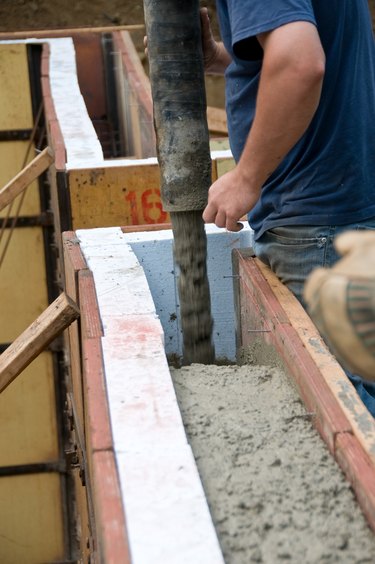
Unlike insulation batts, rigid foam planks or plastic wraps, blown-in insulation is a loose, airy material that, as the name implies, is blown by a machine into uninsulated areas of the home. You can add blown-in insulation during construction, or to retrofit an existing home, even inside finished walls. R-value, or thermal resistance value, is the measured ability of insulation to retard rather than transmit heat. The higher the R-value, the more effective the insulation.
Three types of blown-in insulation are available to the homeowner interested in reducing air leaks and reduce heating and air conditioning costs, and each has its advantages and drawbacks.
Video of the Day
Video of the Day
Cellulose
Made from wood fibers such as cardboard and newsprint, cellulose insulation particles nestle tightly together inside walls and on attic floors. This blown-in insulation provides an R-value of 3.6 to 3.8 per inch, which is slightly higher than other types of blown-in insulation. To get to a comfortable R-38, you need 10 to 12 inches of cellulose, which is less than other types of blown-in insulation. Cellulose is suitable for 1/2-inch drywall on 16-inch centers, but not on 24-inch centers. Cellulose normally has added chemicals for fire and insect resistance. A machine easily blows cellulose into walls through small access holes, but take care not to let it touch heat or light fixtures.
Rock Wool
Made from natural minerals, rock wool is naturally fire resistant, so no potentially hazardous chemicals are needed. Rock wool has an R-value of 3.0 to 3.3 per inch. It takes between 11.5 and 13 inches of rock wool blown-in insulation to attain an R-value of 38. Rock wool weighs 1.6 to 1.8 pounds per square foot, making it too heavy for 1/2-inch drywall set 24-inches on center. Like cellulose, rock wool is suitable for 1/2-inch drywall 16 inches on center and 5/8-inch drywall, 24 inches on center.
Fiberglass
One major drawback of loose-fill fiberglass insulation is the possibility that loose particles may float around in the home. Fiberglass loose-fill insulation is made of glass fibers and normally uses up to 30 percent recycled glass. On the plus side, fiberglass insulation repels moisture, mildew and fungi. The material does not rot, and a new system of blowing the material into a special net helps combat free-floating particles while increasing the material's R-value from its usual 2.2 to 2.7 to around 4.2 per inch. Fiberglass is the lightest blown-in insulation material, weighing just 0.5 to 1.2 pounds per square foot. Blown-in fiberglass is suitable for thin, 1/2-inch drywall installed 24 inches on center.
Overall Advantages and Disadvantages
Blown-in insulation is generally less expensive than other types, making it a good choice for homeowners who need better insulation to reduce energy costs and also want to save money on materials.
Over time, blown-in insulation settles, reducing its effectiveness. Even if excess material is added initially, the insulation can settle as much as 20 percent within a few years of installation.
- U.S. Deparment of Energy: Energy Savers -- Loose-Fill Insulation
- U.S. Deparment of Energy: Energy Savers -- Fiberglass Insulation Material
- U.S. Deparment of Energy: Energy Savers -- Cellulose Insulation Material
- U.S. Deparment of Energy: Energy Savers -- Mineral Wool Insulation Materials
- U.S. Deparment of Energy: Energy Savers -- Vermiculite and Perlite Insulation Materials
- Bob Vila; Blown and Sprayed Insulation; Benjamin Hardy
- U.S. Department of Energy: ZIP-Code Insulation Program
- North Carolina State University; Does Your Home Need More Insulation?; January 2004
- Energy Star: Methodology for Estimated Energy Savings from Cost-Effective Air Sealing and Insulating